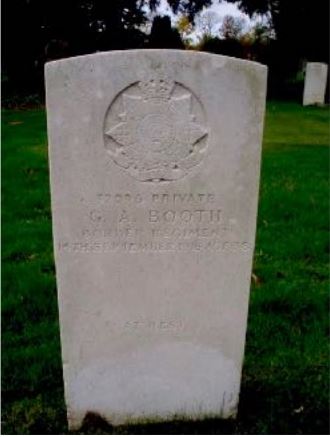5th Battalion, Border Regiment

George Albert Booth came from the East End of London, born in 1880 at Stepney, one of six children born to Thomas Wilson Booth and his wife Mary Ann. According to both the 1901 and 1911 Census his occupation was a print machine worker, however, on his attestation papers for military service he stated this to be a Post Office Sorter (temporary).
On 24 September 1910 George married Elizabeth Emily Garrow (who was four years younger) at the East London Tabernacle Baptist Church, Mile End Old Town and the couple lived at 86 Goldsmith Avenue, Manor Park. They had one child, Edith Mary Booth, who was born on 15 May 1914 but sadly died of tubercular peritonitis on 3 July 1917.
George attested for military service under the terms of ‘Lord Derby’s Scheme’ or the ‘Group Scheme’ on 9 December 1915, three days before the scheme was closed and compulsory conscription brought in. Having attested and being aged 35, married with a child George would have been in one of the last groups to be mobilised and this did not happen until 20 June 1916.
Fortunately his Service Record is one of those to have survived the incendiary bombs dropped onto the Army Records Office in 1940, albeit in a damaged state, so we do know quite a lot of detail as to his Army service.
It would appear that George was initially posted to the Rifle Brigade (number 23224) and then on to the Loyal North Lancashire Regiment (number 16988) whilst undergoing training in the UK. Upon being posted to France on 18 October 1916, he joined the Border Regiment at the vast training camp at Etaples one day later. It is believed that he joined the 11th (Service) Battalion of the Border Regiment (known as ‘The Lonsdales’) in the field on 4 November 1916 and if this is the case he is likely to have seen action when 97 Brigade, 32 Division took part in the attack on Munich and Frankfort Trenches on 18 November, as part of the Battle of the Ancre, in the final stages of the 1916 Somme Offensive.
On 23 December 1916 he went down with influenza and was treated in 75 and 76 Field Ambulance before rejoining his battalion on 21 January 1917. On 30 May 1917 he was wounded and was unable to return to his battalion until 4 August of that year. Just over a month later, on 18 September, he was treated at a casualty clearing station for an attack of gastro-enteritis, transferring to (probably) No 32 Stationery Hospital (known as Australian Volunteer Hospital) at Wimereux. It appears that he had two bouts of this infection, as he was at the same hospital from 13 October to 24 November 1917.
In the spring of 1918 there was a re-organisation of battalions and divisions and the 11th Borders became a training unit with surplus men transferred to the 1/5th Battalion on 7 May 1918. George was one of the surplus transferred but remained in 97 Brigade, 32 Division.
On 27 August 1918, during the advance in the Somme sector George was wounded once more and after initial treatment at a field ambulance was sent to 48 Casualty Clearing Station the same day before arriving at No 6 General Hospital, Rouen on 30 August. He repatriated to England on 2 September 1918.
He was admitted to Suffolk Hall Voluntary Aid Detachment Hospital, Lypiatt Road, Cheltenham on 3 September 1918 with a gunshot wound to his right temple, which had been stitched. He complained of drowsiness and headaches and an abscess on the brain was suspected. This proved to be the case upon exploration and a linear fracture of the front bone was also present. Attempts were made to drain the abscess and he underwent two lumbar punctures. However, his condition continued to deteriorate and he died at 3.30pm on 14 September 1918, aged 38, with his relatives present. According to a report in the Gloucestershire Echo of 16 September he was operated on at the 2nd Southern General Hospital Bristol (as Suffolk Hall was not undertaking operations by that stage of the war) but it appears likely that he had returned to Suffolk Hall (a satellite hospital for 2nd Southern General) where he died, as he was buried in Cheltenham Cemetery, where a standard CWGC headstone marks his grave and his funeral was in Cheltenham. He is commemorated on the Leytonstone War Memorial.
George’s widow was living at 33 Dyers Hall Road, Leytonstone, London E11 when the CWGC compiled its register. She had lost a husband and a daughter inside 14 months. She does not appear to have re-married and died at Southend-on-Sea in 1947.
Researched by Graham Adams 30 November 2015
